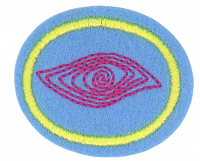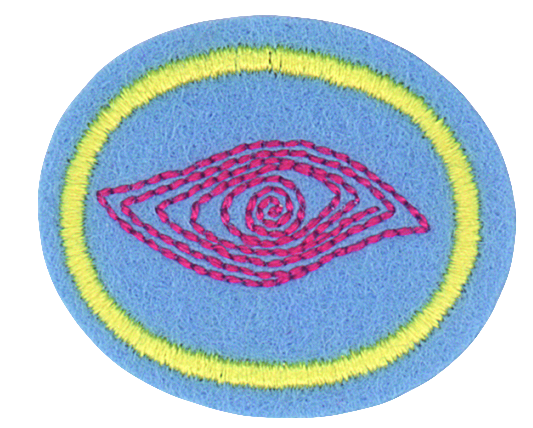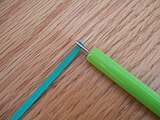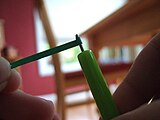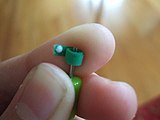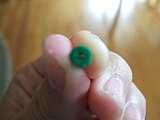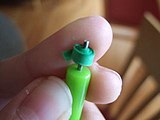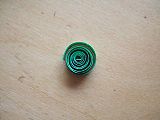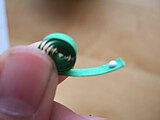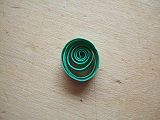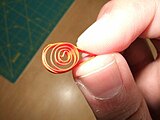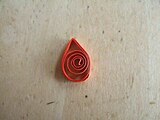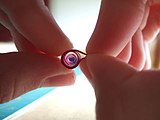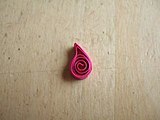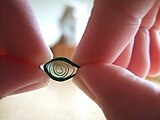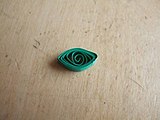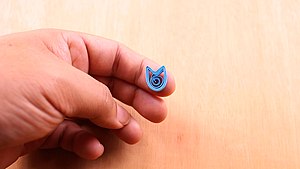Difference between revisions of "AY Honors/Paper Quilling/Answer Key"
Jomegat bot (talk | contribs) m (Jomegat bot moved page AY Honor Paper Quilling to AY Honor Paper Quilling Answer Key: Bot: Moved page) |
m (- Category of AYHAB) |
||
| (7 intermediate revisions by 3 users not shown) | |||
| Line 1: | Line 1: | ||
| − | < | + | {{HonorSubpage}} |
| − | <noinclude><translate><!--T: | + | <section begin="Body" /> |
| + | {{ansreq|page={{#titleparts:{{PAGENAME}}|2|1}}|num=1}} | ||
| + | <noinclude><translate><!--T:17--> | ||
</noinclude> | </noinclude> | ||
| − | + | <!-- 1. What was paper quilling called when the craft first began? --> | |
| − | |||
| − | |||
| − | |||
| − | |||
| − | |||
| − | |||
| − | |||
| − | |||
| − | |||
| − | |||
Paper quilling was originally called '''paper rolling''' or '''paper filigree''' | Paper quilling was originally called '''paper rolling''' or '''paper filigree''' | ||
| − | ==2. Know the history of quilling. | + | <!--T:18--> |
| + | <noinclude></translate></noinclude> | ||
| + | {{CloseReq}} <!-- 1 --> | ||
| + | {{ansreq|page={{#titleparts:{{PAGENAME}}|2|1}}|num=2}} | ||
| + | <noinclude><translate><!--T:19--> | ||
| + | </noinclude> | ||
| + | <!-- 2. Know the history of quilling. --> | ||
During the Renaissance, French and Italian nuns and monks used quilling to decorate book covers and religious items. The paper most commonly used was strips of paper trimmed from the gilded edges of books. These gilded paper strips were then rolled to create the quilled shapes. Quilling often imitated the original ironwork of the day. | During the Renaissance, French and Italian nuns and monks used quilling to decorate book covers and religious items. The paper most commonly used was strips of paper trimmed from the gilded edges of books. These gilded paper strips were then rolled to create the quilled shapes. Quilling often imitated the original ironwork of the day. | ||
In the 18th century, quilling became popular in Europe where "ladies of leisure" practiced the art. Quilling also spread to the Americas and there are a few examples from Colonial times. Many of the pieces that have been preserved from this time are found religious plaques and artwork. | In the 18th century, quilling became popular in Europe where "ladies of leisure" practiced the art. Quilling also spread to the Americas and there are a few examples from Colonial times. Many of the pieces that have been preserved from this time are found religious plaques and artwork. | ||
Today, quilling is seeing resurgence in popularity. The craft has become increasingly popular due to the low cost of the basic material, paper, that is required to make the shapes. It is used to decorate wedding invitations, birth announcements, greeting cards, scrapbook pages, and boxes. Quilling can be found in art galleries in Europe and in the United States and is an art that is practiced around the world. | Today, quilling is seeing resurgence in popularity. The craft has become increasingly popular due to the low cost of the basic material, paper, that is required to make the shapes. It is used to decorate wedding invitations, birth announcements, greeting cards, scrapbook pages, and boxes. Quilling can be found in art galleries in Europe and in the United States and is an art that is practiced around the world. | ||
| − | ==3. Know the tools used in quilling | + | <!--T:20--> |
| + | <noinclude></translate></noinclude> | ||
| + | {{CloseReq}} <!-- 2 --> | ||
| + | {{ansreq|page={{#titleparts:{{PAGENAME}}|2|1}}|num=3}} | ||
| + | <noinclude><translate><!--T:21--> | ||
| + | </noinclude> | ||
| + | <!-- 3. Know the tools used in quilling --> | ||
*Quilling Wand (Slotted Tool) | *Quilling Wand (Slotted Tool) | ||
*Paper strips | *Paper strips | ||
| Line 27: | Line 31: | ||
*Pins and Cardboard (to make eccentric coils if wanted) | *Pins and Cardboard (to make eccentric coils if wanted) | ||
| − | ==4. Know and be able to correctly make each of the following rolls:== <!--T: | + | <!--T:22--> |
| − | + | <noinclude></translate></noinclude> | |
| + | {{CloseReq}} <!-- 3 --> | ||
| + | {{ansreq|page={{#titleparts:{{PAGENAME}}|2|1}}|num=4}} | ||
| + | <noinclude><translate><!--T:23--> | ||
| + | </noinclude> | ||
| + | <!-- 4. Know and be able to correctly make each of the following rolls: --> | ||
| + | <noinclude></translate></noinclude> | ||
| + | {{ansreq|page={{#titleparts:{{PAGENAME}}|2|1}}|num=4a}} | ||
| + | <noinclude><translate><!--T:24--> | ||
| + | </noinclude> | ||
<gallery perrow=2 widths=300px> | <gallery perrow=2 widths=300px> | ||
image:Paper Quilling 1.jpg|1. To make a tight circle, take a quilling wand and a paper strip cut the you desired length. Put the end of the paper strip into the slot on the quilling wand. | image:Paper Quilling 1.jpg|1. To make a tight circle, take a quilling wand and a paper strip cut the you desired length. Put the end of the paper strip into the slot on the quilling wand. | ||
| Line 36: | Line 49: | ||
</gallery> | </gallery> | ||
| − | == | + | <!--T:25--> |
| + | <noinclude></translate></noinclude> | ||
| + | {{CloseReq}} <!-- 4a --> | ||
| + | {{ansreq|page={{#titleparts:{{PAGENAME}}|2|1}}|num=4b}} <!--T:6--> | ||
| + | <noinclude><translate><!--T:26--> | ||
| + | </noinclude> | ||
<gallery perrow=2 widths=300px> | <gallery perrow=2 widths=300px> | ||
Image:Circle.jpg|1. The loose circle is almost the same as a tight circle. You start off the same way as you did with the tight circle but when you get to the end of the strip, don't put any glue on the strip, but pull the circle off the quilling wand. | Image:Circle.jpg|1. The loose circle is almost the same as a tight circle. You start off the same way as you did with the tight circle but when you get to the end of the strip, don't put any glue on the strip, but pull the circle off the quilling wand. | ||
| Line 44: | Line 62: | ||
</gallery> | </gallery> | ||
| − | == | + | <!--T:27--> |
| + | <noinclude></translate></noinclude> | ||
| + | {{CloseReq}} <!-- 4b --> | ||
| + | {{ansreq|page={{#titleparts:{{PAGENAME}}|2|1}}|num=4c}} <!--T:7--> | ||
| + | <noinclude><translate><!--T:28--> | ||
| + | </noinclude> | ||
<gallery perrow=2 widths=300px> | <gallery perrow=2 widths=300px> | ||
Image:Teardroppaper.jpg|1. To make a teardrop, start out with a loose circle. Pinch one side of the circle into a point | Image:Teardroppaper.jpg|1. To make a teardrop, start out with a loose circle. Pinch one side of the circle into a point | ||
| Line 50: | Line 73: | ||
</gallery> | </gallery> | ||
| − | == | + | <!--T:29--> |
| + | <noinclude></translate></noinclude> | ||
| + | {{CloseReq}} <!-- 4c --> | ||
| + | {{ansreq|page={{#titleparts:{{PAGENAME}}|2|1}}|num=4d}} <!--T:8--> | ||
| + | <noinclude><translate><!--T:30--> | ||
| + | </noinclude> | ||
<gallery perrow=2 widths=300px> | <gallery perrow=2 widths=300px> | ||
| − | Image:Shaped tear.jpg| | + | Image:Shaped tear.jpg| 1. To make a shaped teardrop, start off with a teardrop, but curl the point downwards. |
| − | Image:Shapedteardrop.jpg| 2. And now you | + | Image:Shapedteardrop.jpg| 2. And now you have made a shaped teardrop! |
</gallery> | </gallery> | ||
| − | == | + | <!--T:31--> |
| + | <noinclude></translate></noinclude> | ||
| + | {{CloseReq}} <!-- 4d --> | ||
| + | {{ansreq|page={{#titleparts:{{PAGENAME}}|2|1}}|num=4e}} <!--T:9--> | ||
| + | <noinclude><translate><!--T:32--> | ||
| + | </noinclude> | ||
<gallery perrow=2 widths=300px> | <gallery perrow=2 widths=300px> | ||
Image:Marquise! .jpg| 1. to make a marquise, start off with a loose circle, then pinch it on opposite sides. | Image:Marquise! .jpg| 1. to make a marquise, start off with a loose circle, then pinch it on opposite sides. | ||
| Line 62: | Line 95: | ||
</gallery> | </gallery> | ||
| − | == | + | <!--T:33--> |
| − | === | + | <noinclude></translate></noinclude> |
| − | === | + | {{CloseReq}} <!-- 4e --> |
| − | + | {{ansreq|page={{#titleparts:{{PAGENAME}}|2|1}}|num=4f}} <!--T:10--> | |
| − | + | <noinclude><translate><!--T:34--> | |
| − | + | </noinclude> | |
| − | === | + | <noinclude></translate></noinclude> |
| − | + | {{CloseReq}} <!-- 4f --> | |
| − | + | {{ansreq|page={{#titleparts:{{PAGENAME}}|2|1}}|num=4g}} | |
| + | <noinclude><translate><!--T:35--> | ||
| + | </noinclude> | ||
| + | <noinclude></translate></noinclude> | ||
| + | {{CloseReq}} <!-- 4g --> | ||
| + | {{ansreq|page={{#titleparts:{{PAGENAME}}|2|1}}|num=4h}} | ||
| + | <noinclude><translate><!--T:36--> | ||
| + | </noinclude> | ||
| + | <noinclude></translate></noinclude> | ||
| + | {{CloseReq}} <!-- 4h --> | ||
| + | {{ansreq|page={{#titleparts:{{PAGENAME}}|2|1}}|num=4i}} | ||
| + | <noinclude><translate><!--T:37--> | ||
| + | </noinclude> | ||
| + | <noinclude></translate></noinclude> | ||
| + | {{CloseReq}} <!-- 4i --> | ||
| + | {{ansreq|page={{#titleparts:{{PAGENAME}}|2|1}}|num=4j}} | ||
| + | <noinclude><translate><!--T:38--> | ||
| + | </noinclude> | ||
| + | <noinclude></translate></noinclude> | ||
| + | {{CloseReq}} <!-- 4j --> | ||
| + | {{ansreq|page={{#titleparts:{{PAGENAME}}|2|1}}|num=4k}} | ||
| + | <noinclude><translate><!--T:39--> | ||
| + | </noinclude> | ||
| + | {{clear}} | ||
| + | [[File:Bunny Ear.jpg|thumb|left|Bunny Ear|alt=Bunny Ear.jpg]] | ||
| + | <noinclude></translate></noinclude> | ||
| + | {{clear}} | ||
| + | {{CloseReq}} <!-- 4k --> | ||
| + | {{ansreq|page={{#titleparts:{{PAGENAME}}|2|1}}|num=4l}} | ||
| + | <noinclude><translate><!--T:40--> | ||
| + | </noinclude> | ||
| + | <noinclude></translate></noinclude> | ||
| + | {{CloseReq}} <!-- 4l --> | ||
| + | {{ansreq|page={{#titleparts:{{PAGENAME}}|2|1}}|num=4m}} | ||
| + | <noinclude><translate><!--T:41--> | ||
| + | </noinclude> | ||
| + | <noinclude></translate></noinclude> | ||
| + | {{CloseReq}} <!-- 4m --> | ||
| + | {{ansreq|page={{#titleparts:{{PAGENAME}}|2|1}}|num=4n}} | ||
| + | <noinclude><translate><!--T:42--> | ||
| + | </noinclude> | ||
| − | ==5. Know and be able to correctly make each of the following scrolls:== <!--T: | + | <!--T:43--> |
| − | === | + | <noinclude></translate></noinclude> |
| − | + | {{CloseReq}} <!-- 4n --> | |
| − | == | + | {{CloseReq}} <!-- 4 --> |
| − | + | {{ansreq|page={{#titleparts:{{PAGENAME}}|2|1}}|num=5}} | |
| − | + | <noinclude><translate><!--T:44--> | |
| + | </noinclude> | ||
| + | <!-- 5. Know and be able to correctly make each of the following scrolls: --> | ||
| + | <noinclude></translate></noinclude> | ||
| + | {{ansreq|page={{#titleparts:{{PAGENAME}}|2|1}}|num=5a}} | ||
| + | <noinclude><translate><!--T:45--> | ||
| + | </noinclude> | ||
| + | <noinclude></translate></noinclude> | ||
| + | {{CloseReq}} <!-- 5a --> | ||
| + | {{ansreq|page={{#titleparts:{{PAGENAME}}|2|1}}|num=5b}} | ||
| + | <noinclude><translate><!--T:46--> | ||
| + | </noinclude> | ||
| + | <noinclude></translate></noinclude> | ||
| + | {{CloseReq}} <!-- 5b --> | ||
| + | {{ansreq|page={{#titleparts:{{PAGENAME}}|2|1}}|num=5c}} | ||
| + | <noinclude><translate><!--T:47--> | ||
| + | </noinclude> | ||
| + | <noinclude></translate></noinclude> | ||
| + | {{CloseReq}} <!-- 5c --> | ||
| + | {{ansreq|page={{#titleparts:{{PAGENAME}}|2|1}}|num=5d}} | ||
| + | <noinclude><translate><!--T:48--> | ||
| + | </noinclude> | ||
| + | <noinclude></translate></noinclude> | ||
| + | {{CloseReq}} <!-- 5d --> | ||
| + | {{ansreq|page={{#titleparts:{{PAGENAME}}|2|1}}|num=5e}} | ||
| + | <noinclude><translate><!--T:49--> | ||
| + | </noinclude> | ||
| − | ==6. Make a simple floral design by using at least three of the methods above. | + | <!--T:50--> |
| + | <noinclude></translate></noinclude> | ||
| + | {{CloseReq}} <!-- 5e --> | ||
| + | {{CloseReq}} <!-- 5 --> | ||
| + | {{ansreq|page={{#titleparts:{{PAGENAME}}|2|1}}|num=6}} | ||
| + | <noinclude><translate><!--T:51--> | ||
| + | </noinclude> | ||
| + | <!-- 6. Make a simple floral design by using at least three of the methods above. --> | ||
<!--T:13--> | <!--T:13--> | ||
| Line 90: | Line 196: | ||
{{clear}} | {{clear}} | ||
| − | ==7. Make a filled-in picture or ornament. | + | <!--T:52--> |
| − | ==References== | + | <noinclude></translate></noinclude> |
| + | {{CloseReq}} <!-- 6 --> | ||
| + | {{ansreq|page={{#titleparts:{{PAGENAME}}|2|1}}|num=7}} | ||
| + | <noinclude><translate><!--T:53--> | ||
| + | </noinclude> | ||
| + | <!-- 7. Make a filled-in picture or ornament. --> | ||
| + | <noinclude></translate></noinclude> | ||
| + | {{CloseReq}} <!-- 7 --> | ||
| + | <noinclude><translate></noinclude> | ||
| + | ==References== <!--T:54--> | ||
<noinclude></translate></noinclude> | <noinclude></translate></noinclude> | ||
| − | + | {{CloseHonorPage}} | |
Latest revision as of 21:23, 14 July 2022
1
Paper quilling was originally called paper rolling or paper filigree
2
During the Renaissance, French and Italian nuns and monks used quilling to decorate book covers and religious items. The paper most commonly used was strips of paper trimmed from the gilded edges of books. These gilded paper strips were then rolled to create the quilled shapes. Quilling often imitated the original ironwork of the day.
In the 18th century, quilling became popular in Europe where "ladies of leisure" practiced the art. Quilling also spread to the Americas and there are a few examples from Colonial times. Many of the pieces that have been preserved from this time are found religious plaques and artwork.
Today, quilling is seeing resurgence in popularity. The craft has become increasingly popular due to the low cost of the basic material, paper, that is required to make the shapes. It is used to decorate wedding invitations, birth announcements, greeting cards, scrapbook pages, and boxes. Quilling can be found in art galleries in Europe and in the United States and is an art that is practiced around the world.
3
- Quilling Wand (Slotted Tool)
- Paper strips
- Glue
- Ruler
- Pins and Cardboard (to make eccentric coils if wanted)
4
4a
4b
4c
4d
4e
4f
4g
4h
4i
4j
4k
4l
4m
4n
5
5a
5b
5c
5d
5e
6
These are very fun to make! All you need to know is how to make the basic shapes and scrolls listed above. You can combine the shapes to make beautiful flowers, butterflies, and designs. Then you can glue them onto a card or a piece of paper and hang it in your room. Here is a simple floral design using marquises, S scrolls, loose scrolls, V Scrolls, teardrops, and tight circles.
7
